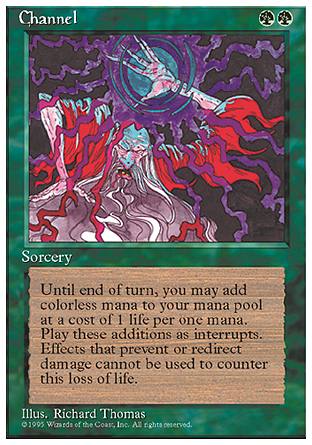Over the last few years, Cube drafting has exploded in popularity. This increased popularity has led to an increase in variety, as people branch out from traditional Cubes to create off-the-wall Cubes with unique drafting experiences. The Joy of Cubing podcast has mentioned many of these Cubes, such as Combo Cube, Mono-Blue Cube, 1-Drop Cube, and Split-Card Cube.
A few months ago, I happened across a forum post that captured my imagination: 1994 Cube. That was the year I started playing Magic, and looking at the list of cards brought back a flood of nostalgia. I knew I had to try it out. I put together a list of my own and immediately noticed a few problems with the available card pool.
Problem #1 – Mana Fixing
Most Cubes have a significant amount of mana fixing between dual lands, mana artifacts, and green ramp spells, but most Cubes have two decades’ worth of cards to choose from instead of two years’ worth. While color screw is a valuable and important part of Magic, it’s also very frustrating when it happens too often. I decided to address this by including two copies of each original dual land and two copies of City of Brass.
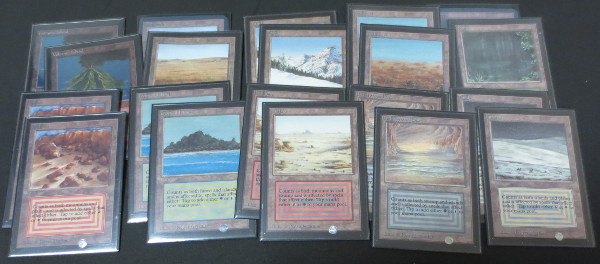
Problem #2 – White Is Terrible
It’s well-known that blue was completely overpowered back in the day, but I had forgotten how miserable white was. While it has some powerful stand-outs such as Balance, Armageddon, and Moat, it’s very shallow. Serra Angel is solid, but most of the white creatures were bad even for their time. I considered trying to help by including multiple copies of key spells, but in the end, I just accepted that achieving any color balance with such a limited card pool would be impossible. I hope white will be underdrafted enough to benefit anyone who does head that direction.
Problem #3 – Enchantment Removal
Let’s run through all the ways that 1994 Magic had to deal with enchantments. As far as the direct approach goes, you have Disenchant and Tranquility. Chaos Orb, Desert Twister, and Nevinyrral's Disk can deal with any permanent, including those pesky enchantments. And . . . that’s it. Five cards. For the most part, it’s not a very big problem, but there are a few powerful enchantments such as Moat and The Abyss that can shut down games.
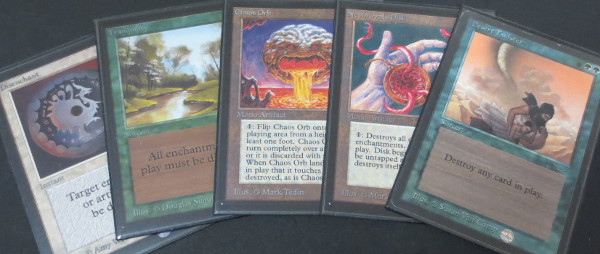
Despite these problems, I was very excited to put it together and play. It took a long time to acquire the necessary cards, but it was a lot of fun. I usually hate trading, but having the goal of completing this Cube made it feel like a quest, and it made me happy to give up value when I came across hard-to-find cards instead of haggling over a couple dollars.
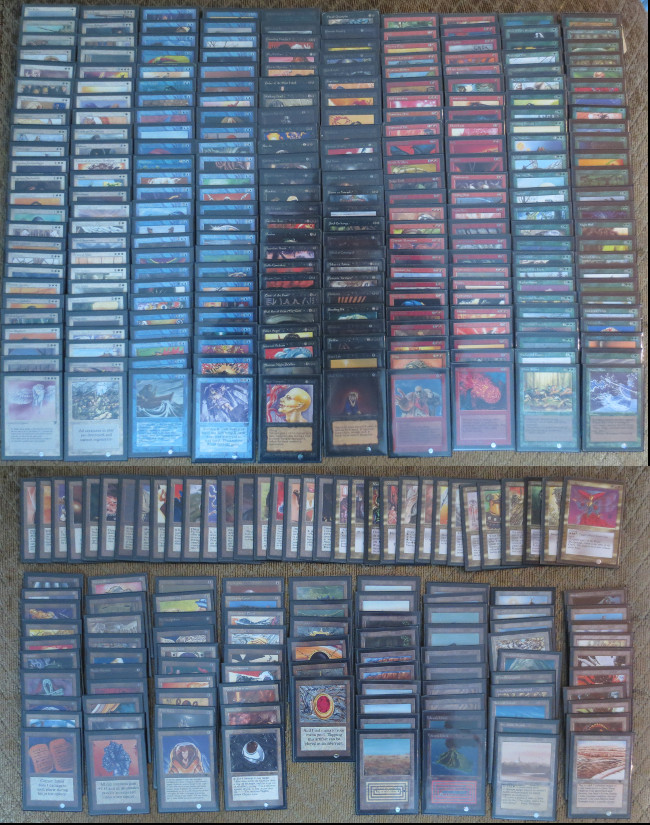
The 1994 Cube Environment
With twenty years of Magic cards available to Cube builders, it's possible to create very specific roles for each color and make card choices with certain Draft decks and color combination in mind. With under two years of cards available for the ‘94 Cube, that's simply not possible. There are fewer than a thousand cards to choose from, so in most cases, I simply chose the strongest cards available—with a few adjustments to smooth out mana curves, increase synergy, and provide combo potential.
"1994 Cube – White"
- Creatures (29)
- 1 Abu Ja'far
- 1 Argivian Archaeologist
- 1 Argivian Blacksmith
- 1 Enchanted Being
- 1 Exorcist
- 1 Farrel's Zealot
- 1 Hand of Justice
- 1 Icatian Javelineers
- 1 Icatian Lieutenant
- 1 Icatian Phalanx
- 1 Icatian Priest
- 1 Keepers of the Faith
- 1 King Suleiman
- 1 Mesa Pegasus
- 1 Moorish Cavalry
- 1 Northern Paladin
- 1 Order of Leitbur
- 1 Pearled Unicorn
- 1 Personal Incarnation
- 1 Petra Sphinx
- 1 Preacher
- 1 Savannah Lions
- 1 Serra Angel
- 1 Thunder Spirit
- 1 Veteran Bodyguard
- 1 Wall of Swords
- 1 War Elephant
- 1 White Knight
- 1 Witch Hunter
- Spells (21)
- 1 Army of Allah
- 1 Blaze of Glory
- 1 Disenchant
- 1 Divine Offering
- 1 Holy Light
- 1 Swords to Plowshares
- 1 Armageddon
- 1 Balance
- 1 Dust to Dust
- 1 Icatian Town
- 1 Resurrection
- 1 Wrath of God
- 1 Angelic Voices
- 1 Circle of Protection Artifacts
- 1 Crusade
- 1 Divine Transformation
- 1 Greater Realm of Preservation
- 1 Island Sanctuary
- 1 Land Tax
- 1 Moat
- 1 Spirit Link
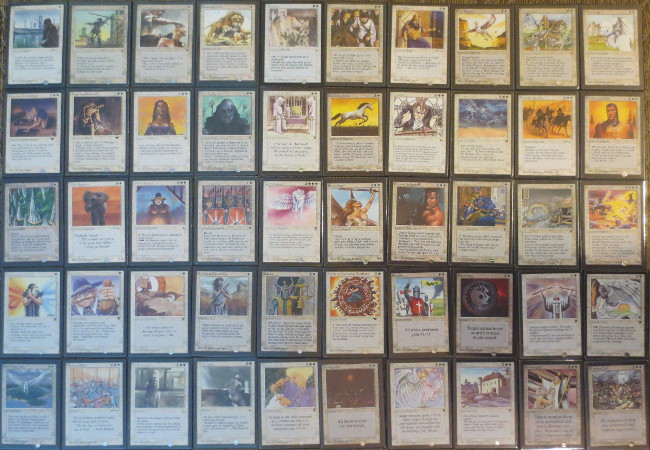
White excels at controlling the board and generating card advantage with cards such as Wrath of God, Moat, Land Tax, and Balance. It also has the most versatile targeted removal in Swords to Plowshares and Disenchant. A handful of utility creatures such as Preacher and Witch Hunter can round out the white half of a control deck nicely.
With Savannah Lions, White Knight, and Order of Leitbur, white has the start of a strong aggressive option as well, but it's difficult to pull together. The pump enchantments (Crusade, Angelic Voices, and Jihad) give white creatures a leg up, but most of those creatures need that leg up. White creatures have the lowest curve, but also the lowest power-to-mana-cost ratio of any of the colors by a significant margin. Drafting the white weenie deck means counting on the key cards to go late (which they do).
"1994 Cube – Blue"
- Creatures (25)
- 1 Air Elemental
- 1 Apprentice Wizard
- 1 Azure Drake
- 1 Clone
- 1 Dandan
- 1 Ghost Ship
- 1 Giant Tortoise
- 1 Lord of Atlantis
- 1 Mahamoti Djinn
- 1 Merfolk Assassin
- 1 Old Man of the Sea
- 1 Phantasmal Forces
- 1 Phantom Monster
- 1 Pirate Ship
- 1 Prodigal Sorcerer
- 1 River Merfolk
- 1 Seasinger
- 1 Segovian Leviathan
- 1 Serendib Djinn
- 1 Serendib Efreet
- 1 Sindbad
- 1 Time Elemental
- 1 Vesuvan Doppelganger
- 1 Wall of Wonder
- 1 Water Elemental
- Spells (25)
- 1 Ancestral Recall
- 1 Boomerang
- 1 Counterspell
- 1 Flash Counter
- 1 Force Spike
- 1 Hurkyl's Recall
- 1 Mana Drain
- 1 Power Sink
- 1 Psionic Blast
- 1 Remove Soul
- 1 Spell Blast
- 1 Unsummon
- 1 Braingeyser
- 1 Recall
- 1 Time Walk
- 1 Timetwister
- 1 Animate Artifact
- 1 Control Magic
- 1 Copy Artifact
- 1 Dance of Many
- 1 Energy Flux
- 1 Flood
- 1 Gaseous Form
- 1 Steal Artifact
- 1 Unstable Mutation
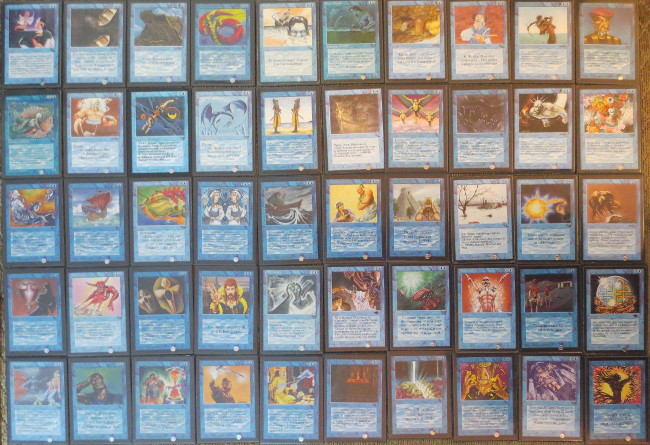
Games in the ’94 Cube often come down to one of two things: punching through damage with evasive creatures or crippling your opponent with broken spells such as Armageddon, Mind Twist, or Earthquake. Blue has the most and the best evasive creatures; plus, it has Prodigal Sorcerer and Pirate Ship to sneak damage through a stalled board. It also has Counterspell and friends, the most effective ways to stop those broken spells from ruining your day.
Blue is certainly the best color in ’94 Cube, but that doesn't mean blue decks are always the best. The most powerful cards usually end up spread across enough drafters to balance it out with the other colors. Blue decks usually have more cards in their other colors but still have significant blue mana needs since most of the best blue cards require two colored mana (Mana Drain, Braingeyser, Control Magic, Mahamoti Djinn), so mana balance can be a problem.
"1994 Cube – Black"
- Creatures (29)
- 1 Banshee
- 1 Black Knight
- 1 Bog Wraith
- 1 Carrion Ants
- 1 Cuombajj Witches
- 1 Demonic Hordes
- 1 Derelor
- 1 Eater of the Dead
- 1 Erg Raiders
- 1 Evil Eye of Orms-by-Gore
- 1 Fallen Angel
- 1 Guardian Beast
- 1 Hasran Ogress
- 1 Hell's Caretaker
- 1 Hypnotic Specter
- 1 Infernal Medusa
- 1 Junun Efreet
- 1 Juzam Djinn
- 1 Lord of the Pit
- 1 Necrite
- 1 Nettling Imp
- 1 Nightmare
- 1 Order of the Ebon Hand
- 1 Royal Assassin
- 1 Sengir Vampire
- 1 Shimian Night Stalker
- 1 Thrull Champion
- 1 Walking Dead
- 1 Will-o'-the-Wisp
- Spells (21)
- 1 Dark Ritual
- 1 Terror
- 1 Word of Command
- 1 Ashes to Ashes
- 1 Demonic Tutor
- 1 Drain Life
- 1 Hellfire
- 1 Hymn to Tourach
- 1 Mind Twist
- 1 Sinkhole
- 1 Soul Exchange
- 1 Animate Dead
- 1 Bad Moon
- 1 Breeding Pit
- 1 Demonic Torment
- 1 Imprison
- 1 Oubliette
- 1 Paralyze
- 1 Pestilence
- 1 Unholy Strength
- 1 Weakness

Black has just about everything you could want. It has cheap defenders such as Will-o'-the-Wisp and Walking Dead. It has strong flyers such as Sengir Vampire and Fallen Angel. It has more removal than any other color, from efficient spot removal such as Terror and Oubliette to sweepers such as Pestilence and Hellfire. It even has reusable removal in the form of Banshee and Royal Assassin.
Black also has access to my favorite combo in the Cube: Guardian Beast plus Chaos Orb. Chaos Orb isn't sacrificed when you use it; it just destroys itself. With Guardian Beast making it indestructible, you can flip Chaos Orb every turn.
Black's main weakness is that it hurts itself quite a lot. Many of the best black cards deal you damage, so you need to be careful not to overload on them. More than once, I've been stuck with an Ashes to Ashes in hand but not enough life to use it.
"1994 Cube – Red"
- Creatures (28)
- 1 Aladdin
- 1 Atog
- 1 Ball Lightning
- 1 Blazing Effigy
- 1 Brassclaw Orcs
- 1 Brothers of Fire
- 1 Crimson Manticore
- 1 Dragon Whelp
- 1 Dwarven Lieutenant
- 1 Dwarven Soldier
- 1 Earth Elemental
- 1 Fire Elemental
- 1 Firestorm Phoenix
- 1 Granite Gargoyle
- 1 Ironclaw Orcs
- 1 Kird Ape
- 1 Mountain Yeti
- 1 Orcish Artillery
- 1 Orgg
- 1 Roc of Kher Ridges
- 1 Rock Hydra
- 1 Rukh Egg
- 1 Sedge Troll
- 1 Shivan Dragon
- 1 Stone Giant
- 1 Two-Headed Giant of Foriys
- 1 Uthden Troll
- 1 Ydwen Efreet
- Spells (22)
- 1 Artifact Blast
- 1 Blood Lust
- 1 Disharmony
- 1 Fissure
- 1 Fork
- 1 Inferno
- 1 Lightning Bolt
- 1 Shatter
- 1 Chain Lightning
- 1 Detonate
- 1 Disintegrate
- 1 Earthquake
- 1 Falling Star
- 1 Fireball
- 1 Pyrotechnics
- 1 Shatterstorm
- 1 Stone Rain
- 1 Wheel of Fortune
- 1 Earthbind
- 1 Immolation
- 1 Mana Flare
- 1 Manabarbs
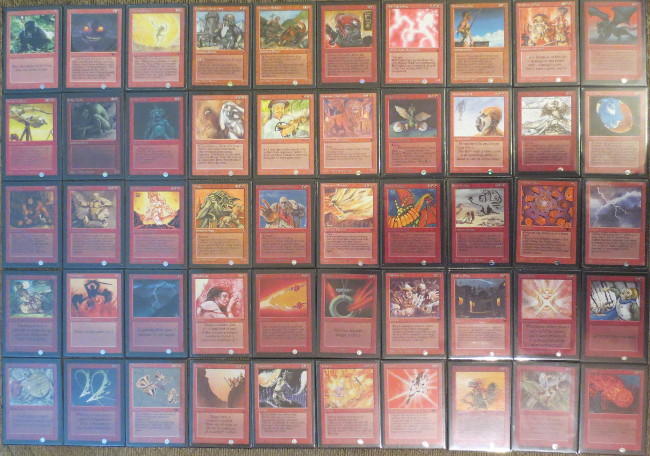
While some elements of the color pie haven't changed much in the past twenty years, other things have changed quite a lot. Even back then, red was the second-best color at killing creatures, and most of the removal is limited by creature toughness. Another mainstay of red is its efficient artifact removal. Artifacts in the ’94 Cube are both common enough and powerful enough that a main-decked Shatter or Detonate is usually going to find a target, and Shatterstorm is quite the blowout against some decks. What may be surprising to newer players is how good red's air force was back in the day; in ’94 Cube, it has more flying creatures than any color but blue. Thanks in part to those flyers, red decks are good at getting in a bunch of early damage before finishing things off with an X spell.
"1994 Cube – Green"
- Creatures (30)
- 1 Argothian Pixies
- 1 Argothian Treefolk
- 1 Barbary Apes
- 1 Birds of Paradise
- 1 Cat Warriors
- 1 Cockatrice
- 1 Craw Giant
- 1 Craw Wurm
- 1 Durkwood Boars
- 1 Elven Riders
- 1 Elves of Deep Shadow
- 1 Elvish Archers
- 1 Erhnam Djinn
- 1 Force of Nature
- 1 Fungusaur
- 1 Giant Spider
- 1 Grizzly Bears
- 1 Ifh-Biff Efreet
- 1 Killer Bees
- 1 Llanowar Elves
- 1 Master of the Hunt
- 1 Radjan Spirit
- 1 Scarwood Bandits
- 1 Scavenger Folk
- 1 Spitting Slug
- 1 Thicket Basilisk
- 1 Tracker
- 1 War Mammoth
- 1 Whirling Dervish
- 1 Wormwood Treefolk
- Spells (20)
- 1 Berserk
- 1 Crumble
- 1 Giant Growth
- 1 Channel
- 1 Desert Twister
- 1 Hurricane
- 1 Ice Storm
- 1 Regrowth
- 1 Tranquility
- 1 Untamed Wilds
- 1 Winter Blast
- 1 Aspect of Wolf
- 1 Drop of Honey
- 1 Fastbond
- 1 Instill Energy
- 1 Lure
- 1 Night Soil
- 1 Sylvan Library
- 1 Titania's Song
- 1 Wild Growth
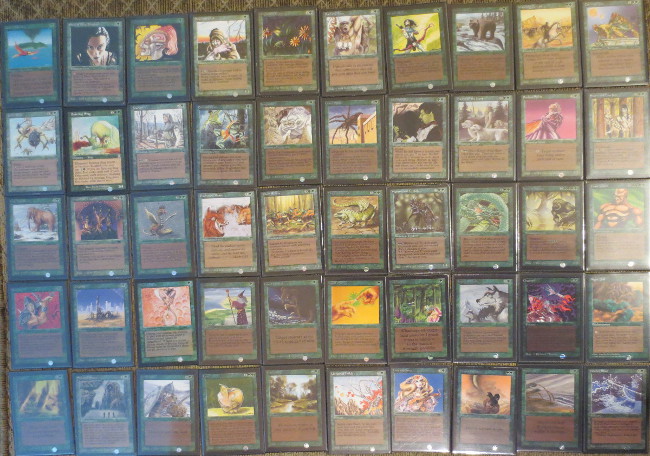
In ’94 Cube, green is among the best halves of an aggressive deck available. Its 2-drops are easier to cast than most, only requiring a single colored mana, and it has a bit of surprise reach between Berserk, Hurricane, and Lure (which once again is Thicket Basilisk's best friend). Green is also valuable for its access to acceleration. The 4- and 5-drops in ’94 Cube can outclass early plays quickly, and Birds of Paradise, Llanowar Elves, and Untamed Wilds help bring you to those spells earlier than your opponent.
"1994 Cube – Lands and Legends"
- Creatures (10)
- 1 Boris Devilboon
- 1 Dakkon Blackblade
- 1 Gabriel Angelfire
- 1 Hazezon Tamar
- 1 Nebuchadnezzar
- 1 Rasputin Dreamweaver
- 1 Rubinia Soulsinger
- 1 Sol'kanar the Swamp King
- 1 Stangg
- 1 Xira Arien
- Lands (40)
- 1 Arena
- 1 Desert
- 1 Dwarven Ruins
- 1 Ebon Stronghold
- 1 Havenwood Battleground
- 1 Island of Wak-Wak
- 1 Library of Alexandria
- 1 Maze of Ith
- 1 Mishra's Workshop
- 1 Ruins of Trokair
- 1 Strip Mine
- 1 Svyelunite Temple
- 2 Badlands
- 2 Bayou
- 2 City of Brass
- 2 Plateau
- 2 Savannah
- 2 Scrubland
- 2 Taiga
- 2 Tropical Island
- 2 Tundra
- 2 Underground Sea
- 2 Volcanic Island
- 4 Mishra's Factory
- 1 Karakas
- 1 Pendelhaven

Some of the lands in the Cube are strong enough to require dedicated answers, which is why Stone Rain, Sinkhole, and Ice Storm made the cut. Library of Alexandria and Mishra's Workshop can take over games quickly, while Maze of Ith, Arena, and Island of Wak-Wak are powerful board-control options available to any deck. In addition to the two of each dual land and City of Brass, I included four Mishra's Factories—one of each seasonal artwork. They're quite a beating when multiples end up in the same deck.

"1994 Cube – Artifacts"
- Creatures (17)
- 1 Brass Man
- 1 Clay Statue
- 1 Clockwork Avian
- 1 Clockwork Beast
- 1 Dancing Scimitar
- 1 Diabolic Machine
- 1 Dragon Engine
- 1 Juggernaut
- 1 Obsianus Golem
- 1 Onulet
- 1 Primal Clay
- 1 Scarecrow
- 1 Shapeshifter
- 1 Su-Chi
- 1 Tetravus
- 1 Triskelion
- 1 Yotian Soldier
- Spells (43)
- 1 Aeolipile
- 1 Al-abara's Carpet
- 1 Aladdin's Ring
- 1 Ankh of Mishra
- 1 Barl's Cage
- 1 Basalt Monolith
- 1 Black Lotus
- 1 Black Vise
- 1 Chaos Orb
- 1 Copper Tablet
- 1 Disrupting Scepter
- 1 Fellwar Stone
- 1 Forcefield
- 1 Gauntlet of Might
- 1 Gauntlets of Chaos
- 1 Horn of Deafening
- 1 Howling Mine
- 1 Icy Manipulator
- 1 Ivory Tower
- 1 Jade Statue
- 1 Jayemdae Tome
- 1 Knowledge Vault
- 1 Mana Vault
- 1 Meekstone
- 1 Mirror Universe
- 1 Mox Emerald
- 1 Mox Jet
- 1 Mox Pearl
- 1 Mox Ruby
- 1 Mox Sapphire
- 1 Nevinyrral's Disk
- 1 Relic Barrier
- 1 Ring of Ma'ruf
- 1 Rocket Launcher
- 1 Rod of Ruin
- 1 Serpent Generator
- 1 Sol Ring
- 1 Tawnos's Coffin
- 1 The Hive
- 1 Voodoo Doll
- 1 War Barge
- 1 Weakstone
- 1 Winter Orb

Everyone becomes excited about the Moxes and Black Lotus, but the artifact section has a lot more to offer than that. Aggressive decks get a lot of mileage from Winter Orb and the direct damage of Ankh of Mishra, Copper Tablet, and Black Vise. There's also good removal in Chaos Orb, Tawnos's Coffin, and Nevinyrral's Disk. One of the more unique decks available in the 1994 Cube is the Titania's Song deck, which uses a lot of artifacts to stall and control the game, and it then casts Titania's Song and crashes in with a surprise army of 4/4s and 5/5s.

Drafting the 1994 Cube
Before each Draft, I give a couple reminders and clarify a few special rules:
- Chaos Orb and Falling Star are in the Cube. Many Cubes include Chaos Orb as a colorless Vindicate, but I want to maintain some of the original feel, so I instead decided that you still have to flip the cards onto the table, but they will only affect one thing of your choice that they touch instead of everything. It’s pretty easy to hit a specific card you’re aiming for, but the one time a player missed with his Chaos Orb during the night, both he and his opponent thought it was hilarious.
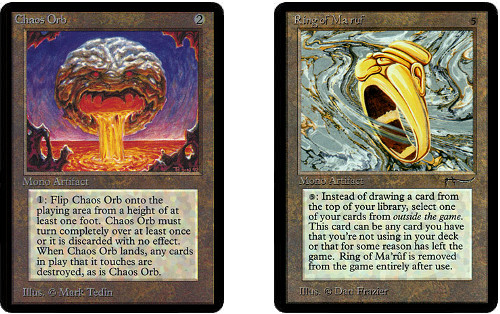
- When Ring of Ma'ruf is used, it grabs any card in Magic that you can think of, whether or not you own it or have a copy of it with you. Paying 10 mana and spending a draw step is a big investment—I want to make sure the reward was worth it.
- Don’t forget to check whether your artifacts are Mono, Poly, or Continuous! Nobody forgets that their Moxes tap when used, but if you’ve never seen an original Icy Manipulator before, the lack of a printed “Tap” in the activation cost might make it look like an overpowered bomb.
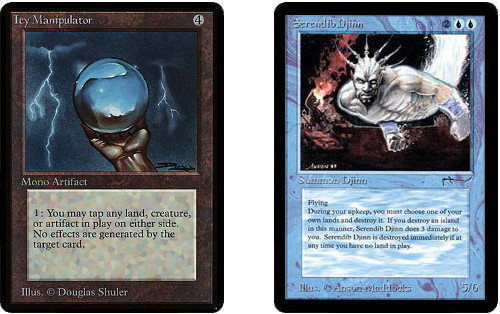
- Make sure you look closely at mana costs, especially for cards from Arabian Nights; the darker printings can make colorless mana symbols difficult to see sometimes. Juzam Djinn and Serendib Djinn are plenty strong at 4 mana, but at a quick glance, they look like they only cost

 and
and 
 respectively.
respectively.
The first time we drafted the 1994 Cube was a three-on-three Team Draft. In it, I first-picked Earthquake and then Disintegrate followed by Erhnam Djinn. My fourth-pick Juzam Djinn tempted me into black, and by the end of the first pack, all I knew was that I was going to be heavily in red with powerful creatures such as Fire Elemental, Roc of Kher Ridges, and Two-Headed Giant of Foriys. I opened Black Lotus in my second pack and then found myself choosing green over black as Ifh-Biff Efreet and Cockatrice gave me some much-needed air support.
When I opened my third pack, I shuddered. Mana Drain, Mahamoti Djinn, Air Elemental, and Phantasmal Forces all stared back at me. I shook my head, took some terrible green creature that I didn’t even play, and passed it on . . . only to see Ancestral Recall in the next pack. I couldn’t pass up that piece of power, and I ended up splashing it off a Tropical Island, my Black Lotus, and basic Island. More exciting was the gift I received two picks later: a Channel to go with my Disintegrate! I started dreaming about winning on turn one with Mountain into Black Lotus into Channel into Disintegrate, and when I came back to reality, the Draft was over.
The deck I played was this:
"1994 Cube Draft Deck"
- Creatures (12)
- 1 Cat Warriors
- 1 Cockatrice
- 1 Dwarven Lieutenant
- 1 Elves of Deep Shadow
- 1 Erhnam Djinn
- 1 Fire Elemental
- 1 Ifh-Biff Efreet
- 1 Roc of Kher Ridges
- 1 Thicket Basilisk
- 1 Two-Headed Giant of Foriys
- 1 Uthden Troll
- 1 Primal Clay
- Spells (9)
- 1 Artifact Blast
- 1 Fissure
- 1 Channel
- 1 Disintegrate
- 1 Earthquake
- 1 Falling Star
- 1 Immolation
- 1 Basalt Monolith
- 1 Black Lotus
- Lands (19)
- 1 Island
- 7 Forest
- 8 Mountain
- 1 Arena
- 1 Maze of Ith
- 1 Tropical Island
I knew I was a little heavy on the 4- and 5-slots of my curve, but was confident I would have enough time to get there. More ramp would have been nice, but the only other piece I saw was Fellwar Stone (the guy passing to me took Wild Growth and Untamed Wilds very early). Was I right to be confident? Read on!
My first opponent had taken a ton of dual lands early on, giving him the freedom to grab powerful cards in multiple colors, though he was based in blue. Mana Drain, Braingeyser, Control Magic, Nevinyrral's Disk, and Steal Artifact were all-stars for him. The card he played that scared me the most, though, was Ring of Ma'ruf. As I mentioned above, it’s expensive to use, but the ability to grab any card in the history of Magic that he could think of proved to be powerful and terrifying to play against. The first time he activated it, my thought was, “Whatever worst-case scenario I can imagine, it’s probably worse than that.” I felt lucky to come away from the match with a win.
In the first game of Round 2, my opening hand contained Channel, Disintegrate, and four lands, with me on the draw. All I had to do was make it to turn four without taking damage, and I could Channel and Disintegrate him out from 20 . . . but then he dropped Onulet on turn three. I was able to kill it with Immolation before it hit me, but that put him at 22 life! Luckily, a few turns later, I was able to hit him down to 18 with my Clockwork Avian and burn him out with the lightning-fast, game-ending combo. It turned out that he could have played a Veteran Bodyguard on his turn five, which would have stopped me from being able to damage him with my Clockwork Avian, but he opted to play the more aggressive Evil Eye of Orms-by-Gore instead. Unfortunately, in the next two games, he wrecked me with the first two picks of his Draft: Balance and Mind Twist. Even a turn-one Erhnam Djinn in Game 2 couldn’t help me overcome those card-advantage powerhouses.
Round 3, it was the battle of the R/G decks. His was faster, with small beaters starting with Kird Ape backed up by Giant Growth, Blood Lust, Berserk, and Lightning Bolt. Luckily, in the first game, he didn't come out fast enough, and I ran him over with fat 5-drops while Arena kept his board clear. In the second game, I kept a slow hand and cringed when he started out with Black Vise.
Over the next two turns, he dropped Howling Mine and Ankh of Mishra, and in no time, we were on to the final game of the night. In it, I made a crucial error by not keeping up mana to stop him from stealing my Clockwork Avian with his Scarwood Bandits. With both of us low on life, he locked up our lands under a Winter Orb. I struggled to stay alive, and on my final turn before his army of puny creatures overran me, I top-decked Black Lotus, giving me just enough mana to Disintegrate and attack for the win.
The 1994 Cube is an absolute blast to draft. It's great playing with cards I haven't cast in over fifteen years and introducing that era to some of the newer players in my area (though the first time I tried to explain banding was not my finest hour). Some of them are now talking about building Cubes for other eras of Magic, whether the time they learned to play or their favorite Standard season. If you were to build a Cube of your own for any era of Magic, what would you choose?
If you have any questions or suggestions for the 1994 Cube, let me know!
Drew Sitte
alteredcity at gmail dot com
@alteredcity on Twitter
If you'd like more pictures of the Cube, check here.













